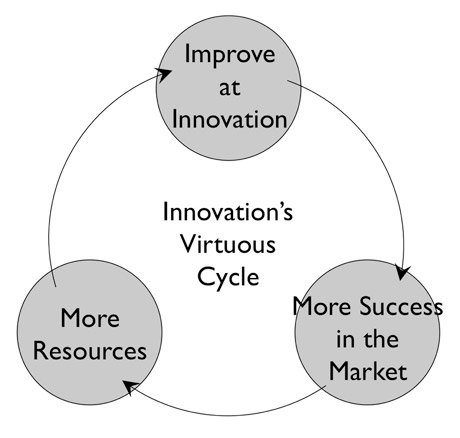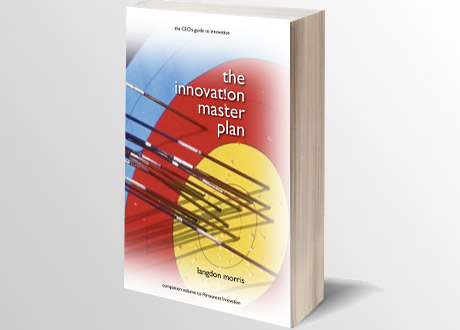By: Langdon Morris
Progress in every field requires a framework that makes the key principles and practices understandable and actionable. In his new book, The Innovation Masterplan, Langdon Morris presents a comprehensive new framework for innovation management. This is the first part in a series of eleven chapters.
Is there any doubt in your mind about the importance of innovation?
Do you feel that innovation is vital to the future of your company?
And perhaps to your own future?
The problem, however, is that innovation, the process of innovation, can be very difficult to manage. It’s risky and expensive, and entirely unpredictable. Einstein reportedly said, “It’s called “research” because we don’t know what we’re doing.” And even if we think we do know what we’re doing, the results frequently fail to live up to expectations.
So now what?
Certainly we have to get better at it by applying tools and methods that will help to improve the process and the results. Even better would be to adopt a systematic approach that includes tools, but also goes beyond them to address the bigger pattern, the large scale risks and opportunities that your organization faces.
That’s the idea behind The Innovation Master Plan. It describes a system for innovation, and helps you design and implement your own Master Plan so you can make it happen, and achieve the virtuous cycle that only innovation can bring.


Overview of the innovation master plan framework
Progress in any field requires the development of a framework, a way of organizing the key concepts and principles to make them useful for action. Law, government, science, technology, business, medicine, all are based on a framework, and each progresses as new insights emerge that improve the depth of understanding and the quality of practice.
Now that the economic change has accelerated and globalized (largely as a result of successful, systematic R&D), and as technology advances along with competition, there is a pervasive need for improved frameworks for systematic innovation.
Organizing the pursuit and creation of innovation through a framework that can be practiced by all types of organizations, large and small, public and private, requires us to address a very broad range of issues. At the same time, it’s best that the framework itself is as simple as possible. We’ve found that a powerful way to think about this, and to devise an Innovation Master Plan is through five simple questions, the five simplest imaginable.
We ask, “Why innovate,” and this quite simple question leads us to explore the strategic nature of innovation. We know that innovation is a strategic necessity, and the evidence shows that any organization that doesn’t innovate probably won’t stay in business. Further, the innovation process must be aligned with an organization’s strategy, as innovation will be a key part of how the strategy is going to be realized.
We ask, “What to innovate,” and we realize that the unpredictable nature of change requires us to prepare many innovation options for a wide range of possible futures. These options constitute an investment portfolio. As with any portfolio, some projects will do well, while others will not. In the case of the innovation portfolio, the disparity between success and failure will be even greater because this portfolio is necessarily geared toward higher risk in order to successfully meet the onrush of change.
We ask, “How to innovate” and we see that a rigorous innovation process is essential. The process must be driven by our strategic intent, the “why” of innovation, so in fact the process itself begins with strategy. The second step is the “what” of innovation, the design of the ideal innovation portfolio. And while many people consider that developing ideas is where innovation begins, we see that ideation is actually in the middle, fifth step of the process.
When we think about “Who innovates” we see that while everyone participates in a robust innovation culture, there are three distinct roles to be played in achieving broad and consistent results. These are Innovation Leaders, who set policy, expectations, goals, and the tone for the innovation culture; Innovation Geniuses, who come up with great ideas; and Innovation Champions, who organize the pursuit of innovation and support those who develop great ideas and turn them into business value. All three roles must be well played for innovation to flourish.
The “where” of innovation is the tools and infrastructure that support the innovation process and the innovating people. The four major elements of this infrastructure are the principles of open innovation that engage the broader community in the innovation process; the virtual infrastructure that supports effective remote communication and collaboration; the physical infrastructure, the work place where people engage together face to face; and collaborative methods that bring forth the best ideas from all participants, inside and outside the organization.
Together these are the five key elements of the Innovation Master Plan.
A last point before we continue is the sixth question, the one I didn’t mention: “When?” But it’s not worthy of a detailed discussion because you already know the answer: the “when” of innovation is obviously now. The market, which ruthlessly demands innovation, and your competitors, who are relentlessly creating innovations of their own, wait for no one. You’d better not wait either.
By Langdon Morris
About the author:


Langdon is also a Contributing Editor and Writer of Innovation Management, Associate Editor of the International Journal of Innovation Science, a member of the Scientific Committee of Business Digest, Paris, and Editor of the Aerospace Technology Working Group Innovation Series.
He is author, co-author, or editor of eight books on innovation and strategy, and a frequent speaker at innovation conferences worldwide. He has lectured at universities on 4 continents.
The Innovation Master Plan: The CEO’s Guide to Innovation is now available at Amazon.com.

